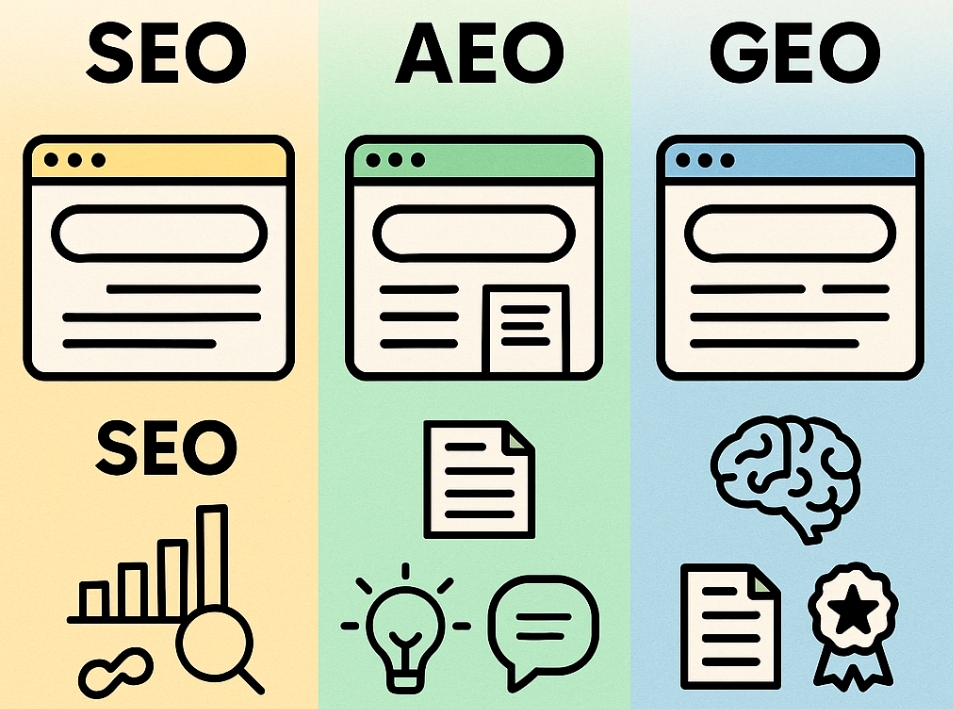SEO vs AEO vs GEO

What is SEO?
- SEO is the process of improving website visibility.
- The goal is to rank higher in search results and boost organic traffic.
- It’s designed to attract potential customers.
How SEO works
- On-page SEO: Optimizing elements on your website like titles, headings, content, and internal links.
- Off-page SEO: Building authority with backlinks, brand mentions, and trust signals.
- Technical SEO: Site speed, mobile-friendliness, crawlability, structured data, and indexability.
- Local SEO: Optimizing for local search queries, including Google Business Profiles and localized content.
- Content Optimization: Creating useful, relevant, and keyword-targeted content for users and search engines.
What is AEO?
- It’s about making content easy for AI-powered systems (like Google, Siri, Alexa) to understand and pull instant answers from.
- Focuses on being found in direct searches and voice queries.
- Content is structured for fast retrieval in:
- Featured snippets
- Knowledge panels
- Voice search results
How to Make AEO Work
- Use scannable structure (headings, bullets, etc.)
- Write concise, direct answers
- Use natural language for voice queries
- Add FAQs, lists, and structured data
Bad Example:
What is SEO? Long, technical paragraph—too dense and not AI-friendly.
Good Example:
“SEO helps your website show up on Google when people search for relevant topics.” Short, clear, and easy for AI to extract.
So, AEO is about clarity. Simpler is better.
What is GEO?
- Prepares content for AI engines like ChatGPT, Gemini, and Perplexity.
- Helps AI analyze and summarize for direct answers.
- Increases the chances of showing up in AI-generated results.
- Focuses on visibility and engagement in AI-driven environments.
How to Make GEO Work
- Use clear headings, structured layout, and clean formatting so AI can understand and pull from it easily.
- Write in a natural, conversational tone that mirrors how people ask questions.
- Prioritize E-E-A-T: Experience, Expertise, Authority, and Trustworthiness.
So GEO is about being AI-readable and trustworthy—less about search bots, more about helping large language models pick your content.
What they all have in common:
- Boosting Online Visibility
- Matching User Intent
- Clear Content Structure
- Technical Enhancements
- Building Credibility (E-E-A-T)
They all aim for better visibility, just in different places:
- SEO → Search engine result pages (SERPs)
- AEO → Direct answers and voice search
- GEO → AI-generated responses
Differences: SEO vs AEO vs GEO
| Category | SEO | AEO | GEO |
|---|---|---|---|
| Goal | Rank higher in Google and increase organic traffic | Provide direct answers via AI/search engines | Help AI tools (like ChatGPT) give accurate responses |
| How It Works | Uses on-page, off-page, and technical SEO tactics | Structures answers for snippets, voice, and knowledge panels | Formats content so AI can interpret and reuse it |
| Key Elements | Keywords, backlinks, meta tags, speed | Direct answers, schema markup, natural tone | Clear structure, conversational tone, E-E-A-T |
| Ranking Factors | Keywords, backlinks, UX, content quality | Clarity, relevance, intent match, structured data | Context, reliability, depth, structured data |
| Content Focus | Long-form, keyword-targeted content | Short, direct, FAQ-style content | AI-readable, well-organized, informative content |
| Optimization | Keywords, tags, backlinks, tech tweaks | Schema, FAQs, natural language | Headings, metadata, structured formatting |
| Visibility | Google SERPs, featured snippets | Featured snippets, voice search, knowledge panels | AI-generated responses (e.g., ChatGPT, Gemini, Perplexity) |
| Best For | Websites, blogs, businesses, eCommerce | Brands targeting voice/instant answers | Content creators, brands aiming for visibility in AI responses |


